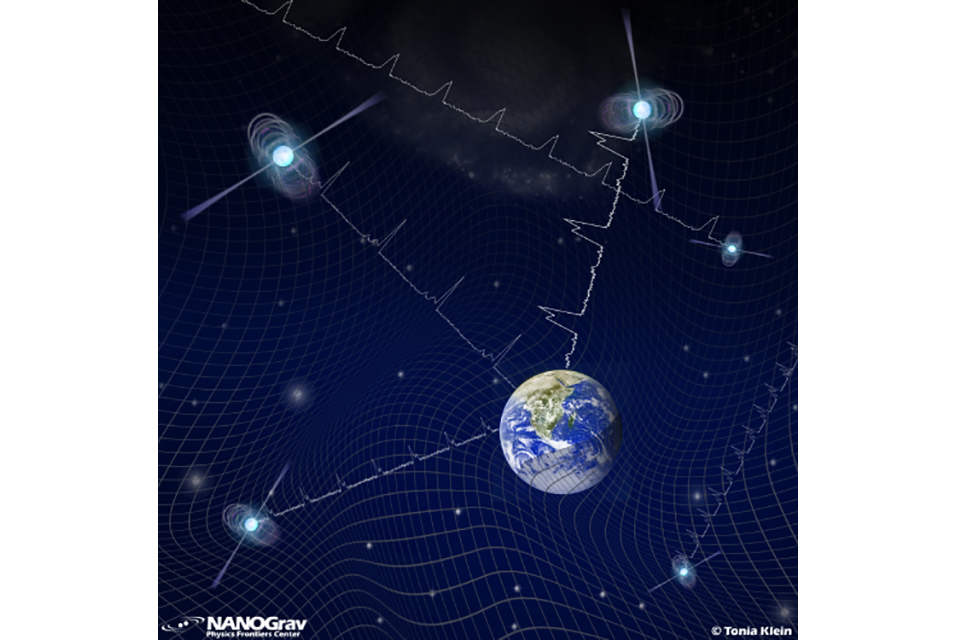NASHVILLE, TN.- An international team including Assistant Professor of Physics and Astronomy Stephen Taylor, postdoctoral fellow in multi-messenger astrophysics Nihan Pol, graduate student William Lamb and incoming graduate student Levi Schult has released its latest gravitational wave search results showing strong evidence for a low-frequency signal. Such a signal could hint at gravitational waves, which may be detected very soon. They also strengthen the emergence of similar signals that have been found in the individual data sets of the participating collaborations over the past few years, including recent results from the North American Nanohertz Observatory for Gravitational Waves (NANOGrav) led locally by Taylor and his team.
Low-frequency gravitational waves originate from pairs of orbiting supermassive black holes or from events that occurred soon after the Big Bang. Detecting these signals will open a new window in the gravitational-wave spectrum and help scientists enhance their understanding of the evolution of galaxies, their central black holes and the early universe.
The data was put together by the International Pulsar Timing Array consortium; it is the result of combined independent data sets from NANOGrav, the European Pulsar Timing Array and Australia’s Parkes Pulsar Timing Array.
The data, called Data Release 2, was analyzed in the article “The International Pulsar Timing Array second data release: Search for an isotropic Gravitational Wave Background,” which was published in the journal Monthly Notices of the Royal Astronomical Society on Jan. 12.
“By fusing together independent data sets from across the world, we see a stronger overall signal because we get more data,” Taylor said. “For the first time, we have searched for low-frequency gravitational waves in this fused data set and, in the process, have confirmed some of the exciting recent results from cutting-edge NANOGrav data and other individual pulsar-timing teams. This was all made possible because of the power of international collaboration and cooperation.”
“In addition to searching this data set for gravitational waves, we did an extensive comparison between individual data sets from the large regional scientific collaborations and the combined data set,” Pol said. “Our early detection of this signal is the first step toward finding the unequivocal evidence of gravitational waves. But we need to monitor more pulsars. We are going to continue observing these pulsars, and new ones, to get a confirmed detection.”
The international group agreed that what they detected thus far is typical of what is found in an all-sky background of gravitational waves. “The signal we found could originate from a cosmic population of pairs of supermassive binary black holes that orbit one another. When they all send out GWs together, the result is like hearing many overlapping voices in a crowded room,” Taylor said. “This analysis demonstrates the power of international cooperation and combination of data. But this is not definitive evidence yet.”
To definitively identify the gravitational-wave background as the origin of the discovered low-frequency signal, the IPTA must also detect correlations between vastly separated pulsars; this means that each pair of pulsars must respond in a very particular way to the gravitational waves depending on their location on the sky. These correlations between pulsar pairs are the “smoking gun” for the detection of the gravitational-wave background; without them, it is difficult to prove that some other process is not responsible for the signal.
“This is a very exciting signal!” said Siyuan Chen, a member of the EPTA and NANOGrav and the leader of the IPTA DR2 search and publication. “Although we do not have definitive evidence yet, we may be beginning to detect a background of gravitational waves.”
NANOGrav collects data using telescopes in Puerto Rico, West Virginia, New Mexico, British Columbia and China, of which the first two were used to produce a nine-year data set. NANOGrav previously reported independent evidence of a potential gravitational-wave signal in its 12.5-year data set. Using the tools and techniques developed for their work, NANOGrav members have played a leading role in the analysis of the IPTA DR2.
Work is ongoing for the IPTA Data Release 3, which, at a minimum, will include updated data sets from the four constituents of the IPTA from North America, Europe, Australia and India. “Our group will be working closely with our international collaborators in the IPTA to design, construct and analyze this new data set to make exciting new gravitational wave breakthroughs,” Taylor said. Vanderbilt researchers on the project include postdoctoral fellows Maria Charisi and Pol; graduate students Lamb, Polina Petrov and Kyle Gersbach; and undergraduate seniors Katie Cella and Joanna Wang.









